Homemade Bagel Recipe
Homemade bagels are simple to make, and I am here to make that process foolproof. Follow my comprehensive step by step bagel recipe guide to perfect bagels.
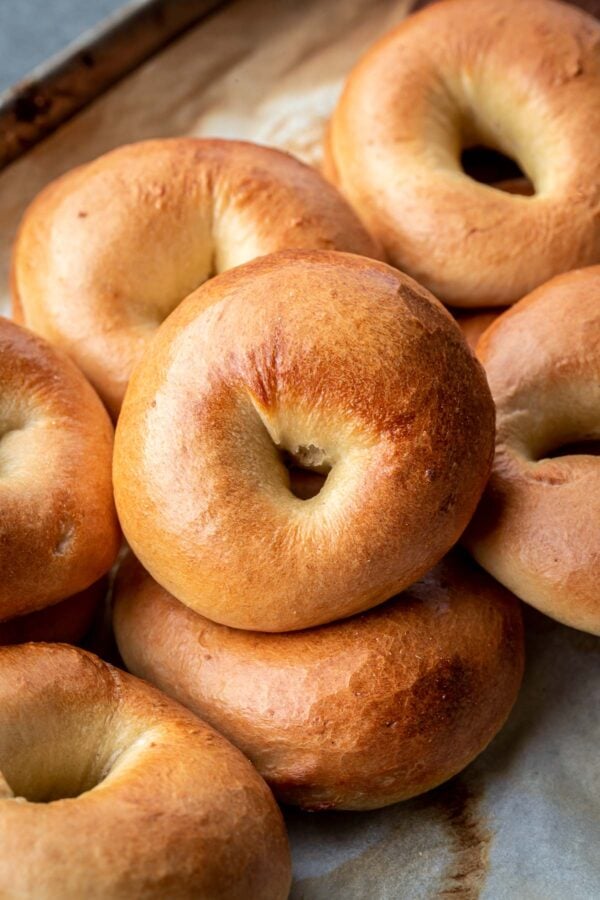
Properly made bagels are chewy on the inside, slightly crispy on the outside, beautifully golden brown and shiny.
What are Bagels?
Originally brought from Poland by Jewish immigrants to New York, the bagels have become very popular outside of the Jewish community only in the last quarter of a century. The donut-shaped, bread-like bagels are crispy and shiny on the outside, while slightly chewy and dense on the inside.
The addition of malt syrup or malt powder in the bagel’s dough makes them taste different than just any bread roll. Also, to achieve the shiny, crispy exterior crust the proofed bagels are boiled in hot water to gelatinize their exterior prior to baking.
Once in the oven, the gelatinized surface expands which makes the bagels look shiny. The boiling prior to baking also helps to keep the moisture inside, which is directly related to the beautiful chewy texture we all love.
How to serve a bagel:
- Slice the bagel in half horizontally, then top with one of the following delicious options
- Cream cheese (a classic)
- Cream cheese, smoked salmon, sliced red onions, sliced tomatoes or cucumbers, dill, and capers.
- Mayonaise, egg, cheese
- Avocado, egg & cheese, microgreens
- Bacon, egg & cheese
- Egg salad, onion, lettuce
- Marinara, paperoni & mozarella (then broil).
- Ham & cheddar
- Tuna salad, tomato, salad leaf
- Pastrami & cheese
- Corned beef, cheese, sauerkraut
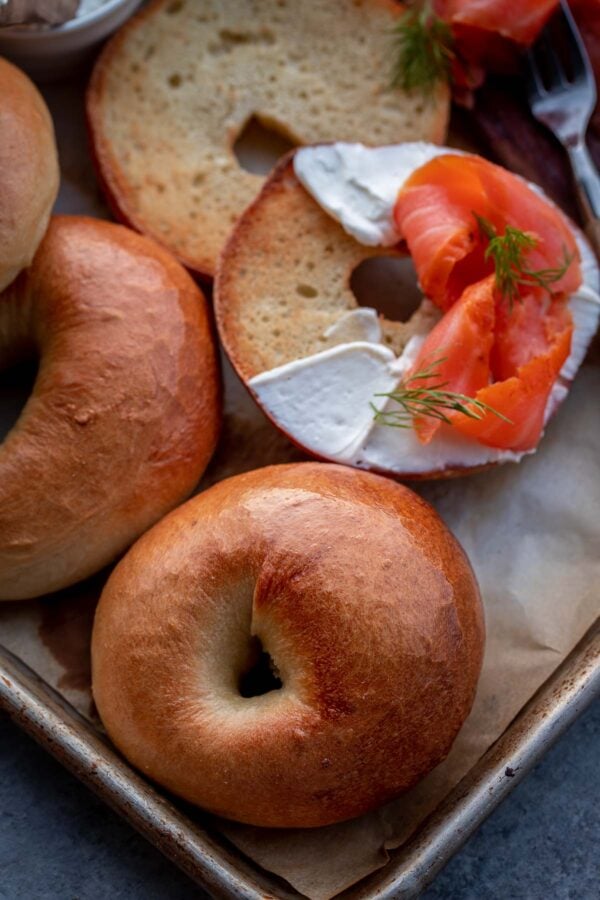
The sheen of the bagels is created by boiling the bagels in water, which gelatinizes the outside of the dough, which in turn creates a shiny exterior when baked.
The Bagel Dough Recipe Ingredients
Instant Dry Yeast – yeast acts as a raising agent in the bagel dough. Either Instant Dry Yeast (which doesn’t need to be dissolved in water) or the Active dry yeast (which needs to be dissolved in water before using) will work for this recipe.
Bread Flour – high gluten content of the bread flour contributes to the wonderful chew in the bagels that we all love. All-purpose flour will work for this recipe, but not as well as the bread flour.
Malt Powder – without the malt powder the bagels will taste like regular bread in the shape of a bagel. Diastatic malt powder is made from sprouted then quickly dried grain (barley or wheat), which is then ground into a powder. The active enzymes help to promote better rise, improve texture and create a beautiful golden-brown crust. While some replace it with brown sugar if at all possible I would recommend you go with malt powder for the authentic bagel flavor.
Salt – balances and enhances the flavor of the baked goods. If put in direct contact with yeast salt will hinder yeast’s rising properties, so when adding take care not to put them in direct contact with each other.
Sugar – added for balanced flavor and to increase browning when baking. It also helps to improve rising in yeast baked goods.
How to Make Bagels:
Scroll to the bottom for detailed recipe and ingredients.
Step by step Homemade Bagel Dough Recipe at a glance:
- Stir together water and yeast, then add flour, sugar, malt powder, and salt.
- Quickly stir to form a shaggy dough.
- Knead the homemade bagel dough until smooth by hand or with a mixer.
Easy way to shape a bagel:
- Divide the dough into 12 equal pieces and form a smooth ball with each piece.
- Poke a hole in the middle then stretch it out into a ring with your fingers.
- Place shaped bagels on a parchment-lined baking sheet, spacing evenly.
- Let rise until about 1 1/2 size of their original size, then cover and refrigerate for 8 -12 hours in the fridge.
How to Boil and Bake Homemade Bagels:
- Preheat oven. Fill a large pot with water halfway, add malt syrup or honey and bring to a boil.
- Drop several bagels into the boiling water for 20-30 seconds to gelatinize the exterior of the bagel. Remove with a slotted spoon.
- Quickly dip or sprinkle the bagels with seasonings if desired, while they’re sticky.
-
- Seasoning options –
- Everything Bagel Seasoning
- Sesame seeds
- Poppy Seeds
- Coarse salt
- Cheese (Asiago, Cheddar)
- Seasoning options –
-
- Transfer to a baking sheet, spacing evenly.
- Bake the homemade bagels until golden in color, but still soft and springy.
- Cool on the rack.
How to store bagels?
Store thoroughly cooled bagels in a ziplock bag at room temperature or freeze thoroughly cooled and wrapped bagels for up to 6 months.
To thaw leave in the fridge until thawed, then cut in half horizontally and toast.
Other yeast baked goods to check out:
Homemade Bagels Recipe
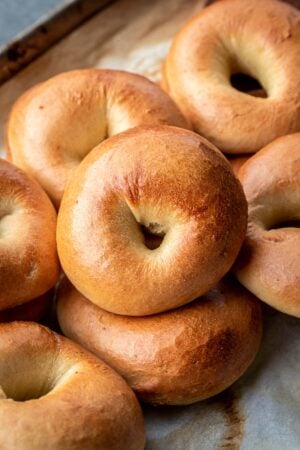
Homemade bagels are simple to make yet, I am here to make that process foolproof. Follow my comprehensive step by step bagel recipe guide to perfect bagels.
Ingredients
Homemade Bagel Dough
- 2 tsp Instant Dry Yeast (Note 1)
- 2 1/4 cup water room temperature
- 1 tbsp granulated sugar
- 1 Tbsp kosher salt
- 6 1/4 cups bread flour (1 cup = 150 g)
- 1 Tbsp diastatic malt powder (Note 2)
Bagel Bath
- 5 quarts water
- 3 Tbsp malt syrup (3 tbsp of malt syrup could be replaced with 1/4 cups honey)
Instructions
-
Start the process the night before or a day ahead of when you need the bagels, as the dough needs to be refrigerated overnight before baking (Note 8 - skipping overnight fermentation).
Mix and knead: In a bowl of a mixer or a large bowl stir 2 tsp instant dry yeast and 2 1/4 cups water. Then add 6 1/4 cups bread flour (weigh the flour for best results), 1 Tbsp sugar, 1 Tbsp kosher salt, and 1 Tbsp of diastatic malt powder and quickly mix with a spoon to bring the ingredients together into a shaggy dough.
Now knead the dough with a mixer or by hand:
Mixer: Fit the mixer with a hook and mix on slow speed for about 4 minutes (Note 3). Turn up the speed to medium and knead for another 5 minutes.
The dough will be stiff but elastic and smooth with well-developed gluten. If the mixer struggles to knead, knead for several minutes, then leave to rest for 5-10 minutes, then continue kneading for several minutes until smooth.
By hand: Alternatively, the dough can be kneaded by hand. Just continue to knead until the dough looks smooth with well-developed gluten.
-
Divide the dough into 10 to 12 equal pieces. Weighing with a kitchen scale is the best way to achieve equal pieces. Otherwise, make a log and divide the dough into 10-12 equal pieces. Roll each piece into a neat smooth ball, then roll the balls into rings starting with the first one you rolled into a ball and work sequentially.
1st way to shape a bagel: rope to ring
- roll all balls into 10-inch logs without flouring the working surface or introducing any flour. Shape the log into a ring by overlapping the ends. Then place 2-3 fingers over the area of the overlap and roll back and forth on the work table to seal the ends together and make them the same thickness as the rest of the ring. The rolled bagel should be 4-inches round with a 2-inch hole in the middle.
2nd way to shape a bagel: ball to ring
- Poke a hole in the middle of the shaped ball and stretch it out until you have a 1.5-2 inch hole and a 4-inch bagel.
-
Ferment/proof: set the shaped bagels on a parchment-lined 15" x 21" baking sheet dusted with flour, spacing them evenly. Leave the shaped bagels at room temp for 30 minutes (Note 4 & 5) to allow them to proof until about 1 1/2 times their original size. The bagels are not meant to be very soft and fluffy, so they need less of a rise time than regular yeast based, baked goods.
Cold retardation: Then, transfer to the fridge to continue proofing (cold retard), covered, for about 12 hours or overnight (Note 6 & 7). They should increase slightly more in volume, but not a lot (to skip the overnight proofing read Note 8).
-
Rest at room temp: After refrigerated fermentation, remove the bagels from the fridge and leave at room temperature, covered for 15 minutes to rest.
-
Meanwhile prep for boiling and baking:
Preheat the oven to 500°F with the rack in the middle.
Meanwhile, fill an 8-quart pot with about 5 quarts of water and add the malt syrup or the honey. Bring to a boil over medium heat.
Set a cooling rack over a baking pan to catch any dripping from the water.
-
Boil: add 2 - 3 bagels to the boiling water and give a gentle stir to prevent them from sticking. Simmer until they float to the top, about 30 seconds rotating them halfway through if they're not fully submerged. Do not boil for too long or the crust will be very thick (Note 9).
Transfer with a slotted spoon to the prepared rack to dry excess water. Add garnish if desired while the bagels are still slightly wet.
-
Bake: Transfer the boiled bagels back to the parchment-lined baking sheet, spacing them evenly and place in the center of the oven. Turn the heat down to 450F and bake for about 15 minutes or until the bagels are golden brown, but still soft and springy to touch. Turn the sheet halfway through baking for even cooking. Cool on a rack before serving.
-
Store thoroughly cooled bagels in a ziplock bag at room temperature or freeze thoroughly cooled and wrapped bagels for up to 6 months.
Recipe Notes
- Instant or Active: Instant Dry Yeast can be replaced with Active dry yeast. To use active dry yeast combine the water and the yeast and leave to proof for about 10 minutes to form a foam cap, then proceed with the recipe.
- Malt powder: do not omit the malt powder, it is what gives the bagels the signature bagel flavor and improves the dough's texture. Without it, the bagels will taste like bagel-shaped bread. But, if getting malt powder is not an option, replace it with brown sugar.
- Dough Texture: The bagel dough is meant to be stiff, this is what gives bagels the chewy texture we like. If the bagel dough is too soft, add a bit more flour. If your dough is too thick mix in 1 tablespoon of water at a time until it softens.
- Increased rise time - if using Active Dry Yeast the rise time will be longer, so increase the proofing time from 30 to about 50 minutes.
- Yeast age: if the yeast is older the proofing time will be extended. Always gauge the proofing time by the increase in volume and not by the amount of time it takes to get there. The older the yeast, the longer it will take.
- Cold fermentation: proper bagels are cold fermented to improve flavor, increase shelf life and give bagels a depth of flavor. Proof overnight for best results.
- Inside texture: if you prefer the bagels to be on the firmer side only allow to proof until 50% bigger. For softer bagels allow to double in size before baking.
- Omitting cold fermentation - just skip to step 5 and allow the bagels to continue proofing (for another 15-20 minutes) as you preheat the oven and prepare the water for boiling.
- Boil the bagels: the hot water gelatinizes the exterior of the bagel which will create a shiny crust when the gelatinized exterior is expanded during baking. Boiling also helps to retain inside moisture for that perfect chewy crumb.
Thank you for following me on Instagram, Facebook & Pinterest!
Hashtag your photos #LetTheBakingBeginBlog so I can see your creations and for a chance to be featured!

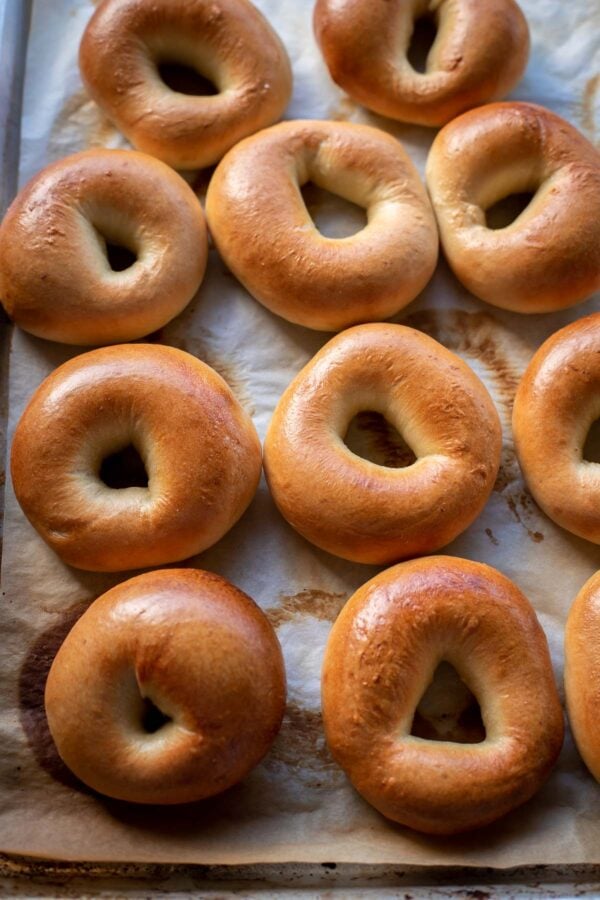

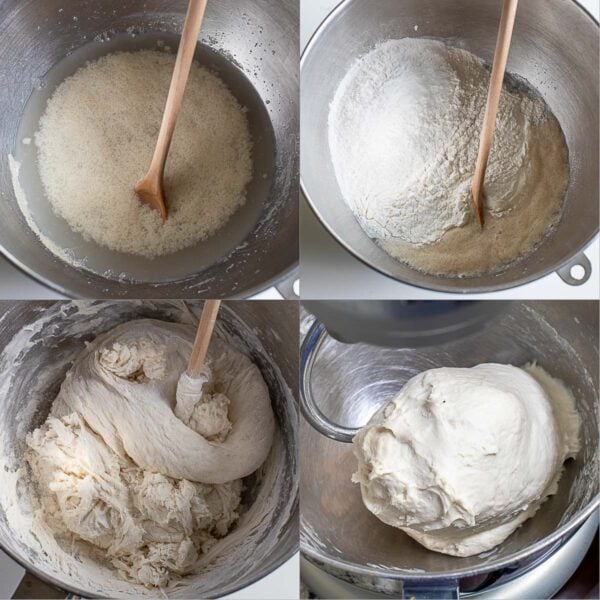

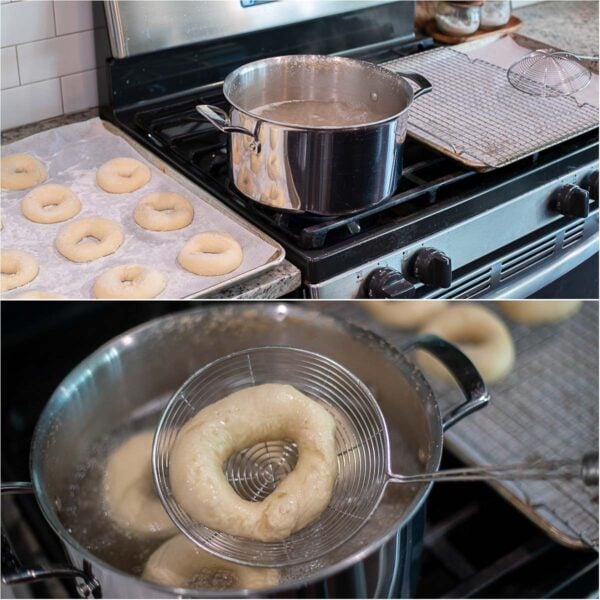





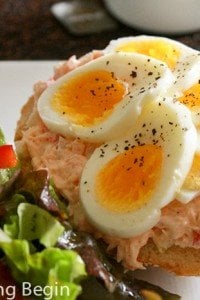



I really want to make perfect bagels because they are my favorite. I tried this recipe and the dough was very soft but the main problem is after I left them in the fridge overnight they flattened completely & stuck horribly to the parchment paper. I reshaped a few and let them sit for a bit and they turned out OK. But not what they should have been.. please tell me what could have gone wrong?
Absolute bagel perfection. First time I have ever tried to make bagels and by using this recipe they tasted just like the New York bagels I grew up with! I will never ever buy bagels again. Thanks so much!
Love hearing that, Jami! Thank you for sharing!
I haven’t made this yet, but I sure want to! I do have a question though. I don’t have malt syrup, but I do have powder… how much of that would I put in the water to replace the syrup?
THANK YOU! I was able to get the most amazing recipe from the site that came free with my Sous Vide maker, but I lost my printed copy and didn’t want to pay the subscription fee. No one else has the correct recipe,
THIS IS A CORRECT BAGEL RECIPE!
Said that caps so everyone can see. There are minor differences in this recipe that make it more correct that the others and they make a huge difference. The diastatic malt powder or barley malt in the mix AND water is important, the overnight proof is key… THANK YOU, did I say that loud enough THANK YOU!
Oh, your comment makes me so happy that you’re appreciating the work that I put in this recipe :D. I have researched and tested many recipes that claimed to be “bagel recipes” before I’ve arrived to this one, but as you’ve pointed, unless you add the diastatic malt powder and leave it overnight, the bagels don’t have the signature flavor.
So happy you found this recipe and liked it 😀
I live everything about your comment! Thank you god your feedback! Appreciate you taking the time to share it ❤️
Hey! Thanks for the recipe!
I have malt powder, but am not sure if it’s diastatic or not. Does this make a difference? If it’s not diastatic, should I still add it?
Also, can this recipe be halved if I want to make less bagels?
Thank you!
Hi Katie,
the recipe can be halved to make less bagels, yes.
I have not worked with with non-diastatic powder so can not tell you for sure, but a little bit of research on the internet tells me that you an substitute one for the other. The non-diastatic malt powder does not have the enzyme that would help the dough rise faster, so it might take a little longer to rise.
Love this recipe
Finally! Someone who has the real recipe! The only difference between this and the 150 year old recipe that was passed down to me is instead of malt barley powder, we used malt barley syrup. I am a fourth generation baker, and it’s nice to see someone else actually stick to the real thing.
You’re my favorite person today . Thank you, so much!